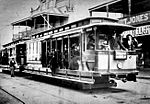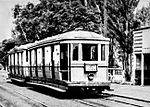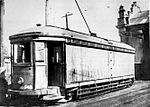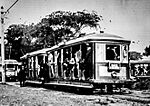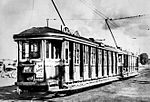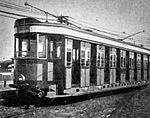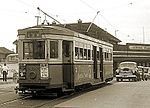There have been two separate generations of trams in London, from 1860 to 1952 and from 2000 to the present. There were no trams at all in London between 1952 and 2000.
Dick, Kerr and Company was a locomotive and tramcar manufacturer based in Kilmarnock, Scotland and Preston, England.

The Kirnitzschtal tramway, also known as the Kirnitzschtalbahn, is an electric tramway in Saxony, Germany. The line runs through the valley of the Kirnitzsch river in Saxon Switzerland, from the town of Bad Schandau up to the Lichtenhain Waterfall, in the municipality of Sebnitz. The line is principally a tourist service, being the only tramway to serve a National Park in Germany, and uses historical rolling stock built between 1925 and 1968.

The Saint-Étienne tramway is a tram system in the city of Saint-Étienne in the Rhône-Alpes (France) that has functioned continuously since its opening in 1881. The first tramway line was steam-operated and was opened by the Chemins de Fer à Voie étroite de Saint-Étienne (CFVE) on 4 December 1881, stretching for 5.5 km between La Terrasse and Bellevue. The CFVE took over the Compagnie des Tramways Électriques de Saint-Étienne lines and discontinued the use of steam in 1912.

The Newcastle Tram System was an extensive network that operated between Newcastle and the outer suburb of Wallsend from 1887–1950. At its peak the line extended from the city to Speers Point and West Wallsend. The service was rarely profitable, and low utilisation for a variety of reasons including the convenience of buses led to it closing and the tracks being removed.
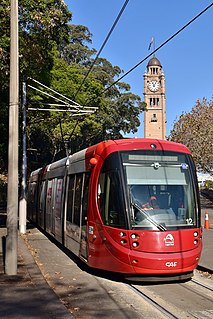
The earliest trams in Australia operated in the latter decades of the 19th century, hauled by horses or "steam tram motors". At the turn of the 20th century, propulsion almost universally turned to electrification, although cable trams lingered in Melbourne. In cities and towns that had trams, they were a major part of public transport assets.
The Swansea Improvements and Tramway Company operated street trams in and around Swansea in Wales from 1878 to 1937.

Dundee Corporation Tramways formerly served the City of Dundee in Scotland. The Corporation had financed the construction of a horse tramway in 1877, but had then leased it to the Dundee and District Tramways Company. They had replaced most of the horse trams with steam tram locomotives pulling trailer cars from 1884, but in 1897 the Corporation decided that it would run the tramway system itself. After some negotiation and the payment of compensation, they took over the system in 1899, with a view to electrifying it. Electric trams started running in 1900, and the changeover was completed in 1902.

Hurst, Nelson and Company Ltd was a railway rolling stock manufacturer based in Motherwell, Scotland. The company also built many railway wagons, as well as trams and trolleybus carosseries for several local authorities.

The Fremantle tramway network linked the central business district of Fremantle, the port city for Perth, Western Australia, with nearby suburbs. Small but comprehensive, it operated between 1905 and 1952.

Trams in Vienna are a vital part of the public transport system in Vienna, capital city of Austria. In operation since 1865, the network reached its greatest extent during the interwar period (1918–1939). Today, it is the fifth largest tram network in the world, at about 176.9 kilometres (109.9 mi) in total length and 1,071 stations.

The Bern tramway network is a network of tramways forming part of the public transport system in Bern, the capital city of Switzerland. In operation since 1890, it presently has five lines, one of which incorporates the Bern–Worb Dorf railway.

The United Electric Car Company was a tramcar manufacturer from 1905 to 1917 in Preston, Lancashire, England.

Coventry Corporation Tramways operated a tramway service in Coventry, England, between 1912 and 1940.

Dundee and District Tramways operated a tramway service in Dundee between 1877 and 1899.
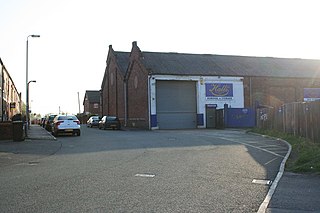
Wigan Corporation Tramways operated a tramway service in Wigan, England, between 1901 and 1931. The first tramway service in the town was run by the Wigan Tramways Company, whose horse trams began carrying passengers in 1880. They began replacing horses with steam tram locomotives from 1882, but the company failed in 1890, when a Receiver was appointed to manage it. The Wigan & District Tramways Company took over the system in 1893, and ran it until 1902. Meanwhile, Wigan Corporation were planning their own tramway system, obtaining an authorising Act of Parliament in 1893, and a second one in 1898. This enabled them to build electric tramways, and in 1902, they took over the lines of the Wigan & District Tramways Company.

The Blackpool and Fleetwood Tramroad operated a tramway service between Blackpool and Fleetwood between 1898 and 1920.

The C-class trams were a class of single bogie end-loading electric trams operated on the Sydney tram network.

The Steam tram motors were built for and operated by the New South Wales Government Tramways of Australia.
Bradford Corporation Tramways were a tramway network in the city of Bradford, West Riding of Yorkshire, England which operated trams from 1882 until 1950 and trolleybuses from 1911 until 1972. The track gauge of the tramways was 4 ft.





